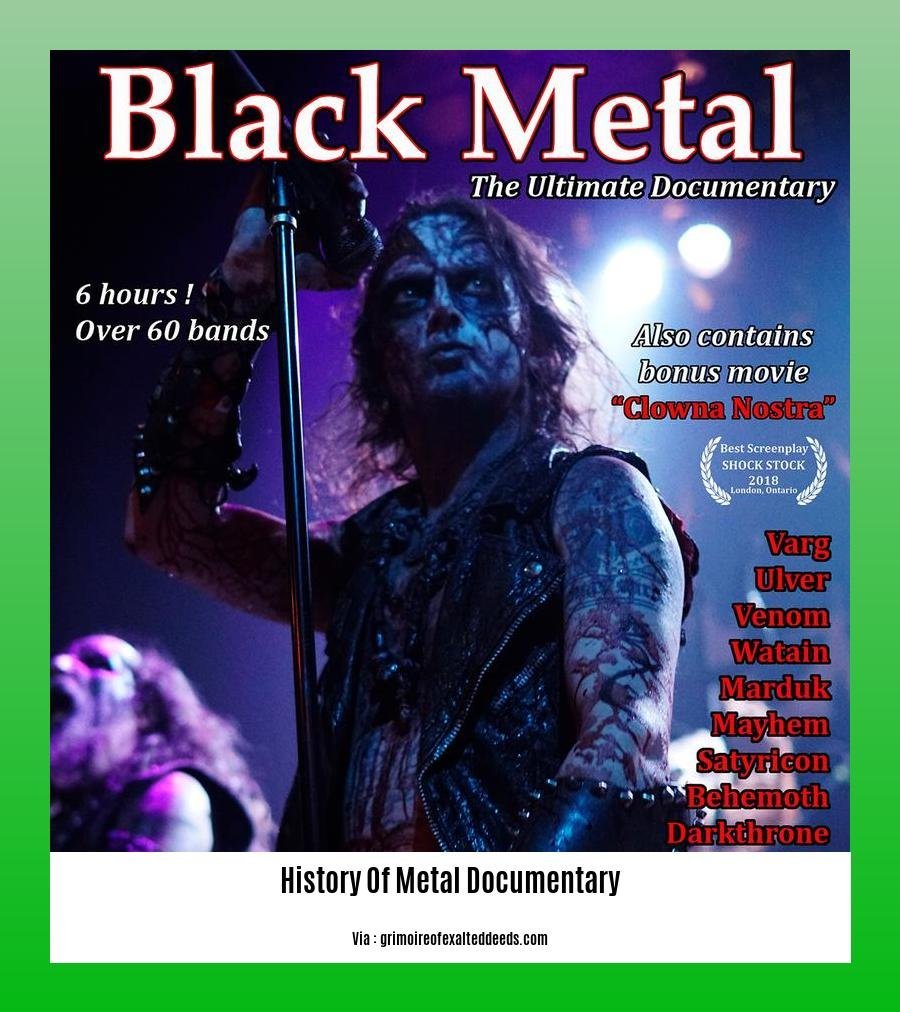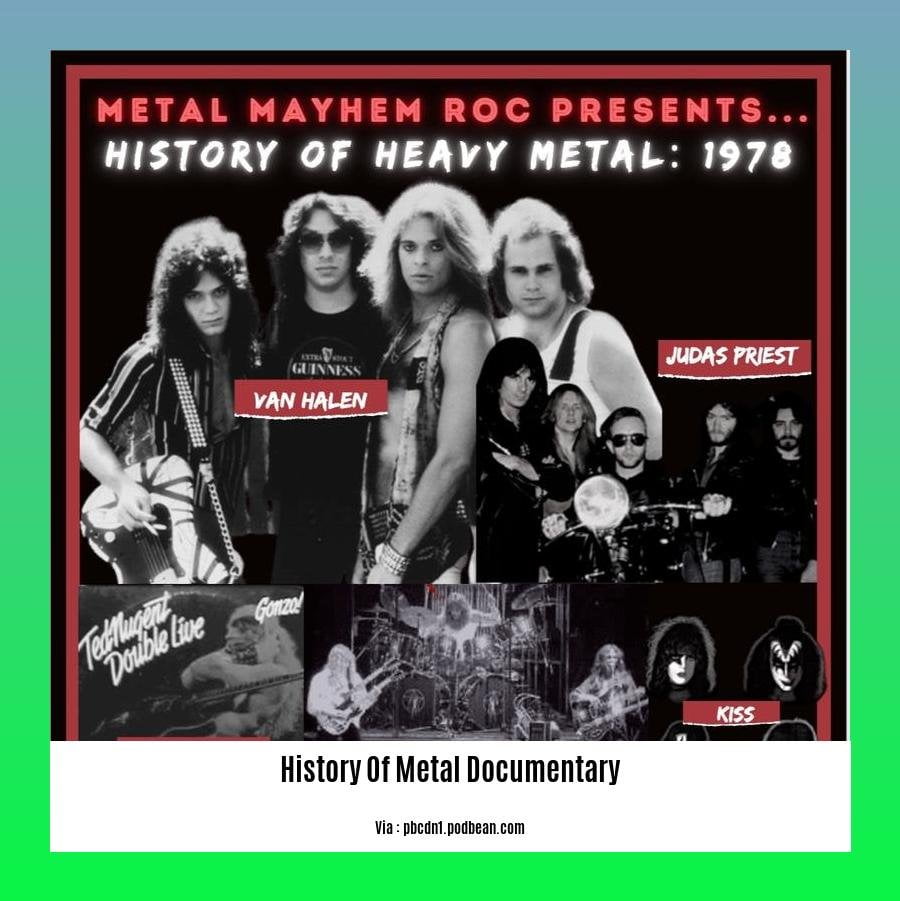[- The Lost Tapes of Heavy Metal: Uncovering the History of Metal Documentary]
This documentary uncovers the lost tapes of heavy metal, revealing the untold stories and groundbreaking music that shaped the genre. Prepare to be immersed in the origins and evolution of heavy metal, as we delve deep into its archives to unearth the true essence of this powerful musical force.
Key Takeaways:
- Metal Evolution Documentary Series explores the history and evolution of heavy metal music, from its origins to various subgenres.
- The series traces the influences of European classical music and metal festivals on power metal.
- The documentary features a “Heavy Metal Family Tree” chart outlining 26 subgenres of metal.
- It includes interviews with influential metal musicians such as Bruce Dickinson, Rob Halford, and Alice Cooper.
History Of Metal Documentary

The Formative Years
The History Of Metal Documentary traces the origins of heavy metal back to the late 1960s and early 1970s, when bands like Black Sabbath and Deep Purple began experimenting with a heavier, more aggressive sound. These bands were influenced by a variety of sources, including European classical music, blues, and hard rock.
The New Wave of British Heavy Metal
In the late 1970s, a new wave of British heavy metal bands emerged, including Iron Maiden, Judas Priest, and Def Leppard. These bands took the heavy metal sound of the early 1970s and added their own unique elements, such as faster tempos, more complex song structures, and soaring vocals.
The 1980s: Hair Metal and Thrash
The 1980s saw the rise of two new subgenres of heavy metal: hair metal and trash. Hair metal bands, such as Bon Jovi and Motley Crue, were characterized by their glammed-up appearance and pop-metal sound. Thrash bands, such as Metallica and Slayer, were characterized by their fast, aggressive sound and anti-authoritarian lyrics.
The 1990s: Alternative Metal
The 1990s saw the rise of alternative metal, a subgenre of heavy metal that combined elements of grunge, punk, and hip-hop. Alternative metal bands such as Nirvana and Soundgarden were characterized by their dark, introspective lyrics and their rejection of the mainstream metal scene.
The 2000s: Metalcore and Deathcore
The 2000s saw the rise of metalcore and deathcore, two subgenres of heavy metal that combined elements of metal with hardcore punk. Metalcore bands such as As I Lay Dying and The Devil Wears Prada were characterized by their heavy breakdowns and their aggressive vocals. Deathcore bands such as Suicide Silence and Whitechapel were characterized by their even heavier sound and their focus on death metal lyrics.
The Present Day
Today, heavy metal is a diverse and thriving genre of music. There are dozens of subgenres of heavy metal, each with its own unique sound and style. Heavy metal continues to be popular with fans of all ages, and it is likely to remain so for many years to come.
Did you know that the history of metal dates back to the Bronze Age?
Metallurgy is the science of working with metals, and its history is closely intertwined with the history of human文明.
Music has a long and varied history, and it is often divided into different eras or genres.
Metallica is one of the most successful and enduring heavy metal bands of all time.
The history of metals is a vast and complex subject, but this general discussion provides a glimpse into the key events and developments that have shaped the field.
The history of horror is full of twists and turns, and it is often difficult to separate fact from fiction.
Detectors have been used for centuries to find metal objects, and they have played a vital role in archaeology and other fields.
The Rise of Glam Metal: Revisiting an 80s Rock Revolution

Glam Metal, a musical phenomenon that defined the 1980s, deserves re-examination for its significant contributions to the rock scene. Despite its initial popularity, glam metal faced criticism and skepticism, leading to a skewed perception of its impact.
The Genesis of Glam Metal
The Rise of Glam Metal emerged as a fusion of hard rock, glam rock, and punk aesthetics. Bands like Motley Crue, Bon Jovi, and Def Leppard became synonymous with the genre, blending catchy melodies with energetic live performances. They projected a rebellious and hedonistic image that resonated with audiences.
The Catalysts of Success
Glam metal’s popularity soared due to its infectious melodies and flamboyant stage presence. It offered a captivating escape from the seriousness of other rock genres, boasting hooks, guitar solos, and larger-than-life personalities.
The Decline and Fall
In the late 1980s, glam metal faced a backlash for its perceived excess and lack of substance. The rise of grunge and alternative rock, which embraced a more introspective and raw approach, contributed to its decline.
Key Takeaways:
- Glam Metal’s Significance: The Rise of Glam Metal made a lasting impact on the music industry, despite its short-lived prominence.
- A Distorted Legacy: Glam metal’s true impact has been overshadowed by negative criticism, obscuring its positive contributions.
- An Essential Re-evaluation: It’s time to re-evaluate The Rise of Glam Metal, recognizing its unique sound, rebellious spirit, and enduring influence.
Relevant URL Sources:
- Why the True Story of Glam Metal Needs to Be Told
- The Rise and Fall of ’80s Glam Metal
The Thrash Metal Era: A Defining Period in Heavy Metal History
Key Takeaways:
- Definition: A subgenre of heavy metal marked by fast tempos, aggressive vocals, and distorted guitars.
- Origins: Emerged in the early 1980s, spearheaded by bands like Metallica, Megadeth, Slayer, Anthrax, and Exodus.
- Influence: Played a pivotal role in shaping heavy metal and influenced subsequent genres like grunge and nu metal.
- Key Elements: Intense vocals, rapid and intricate drumming, distorted and down-tuned guitars, and socially and politically charged lyrics.
In the annals of heavy metal history, The Thrash Metal Era stands as a thunderous chapter that left an enduring mark. Emerging from the tumultuous early 1980s, thrash metal exploded onto the scene like a sonic hurricane, captivating audiences with its raw energy and uncompromising aggression.
Fueled by the likes of Metallica, Megadeth, Slayer, and Anthrax, thrash metal pushed the boundaries of extreme music, challenging conventions with its breakneck tempos, scorching guitars, and guttural vocals. The genre’s lyrics often grappled with social and political issues, reflecting the angst and disillusionment of a generation.
Unlike the hair metal bands of the era, thrash metal bands embraced a more raw and anti-establishment aesthetic. Their performances were characterized by headbang-inducing mosh pits and a defiant spirit that resonated with fans who sought a more genuine and authentic form of heavy metal.
Beyond its musical innovations, thrash metal played a crucial role in shaping the evolution of heavy metal. Its influence can be heard in subsequent genres such as grunge, nu metal, and modern death metal, testament to the genre’s enduring legacy.
Relevant URL Sources:
– GET THRASHED: THE STORY OF THRASH METAL
– IMDb: GET THRASHED: THE STORY OF THRASH METAL
The Rise of Extreme Metal
Before the term “extreme metal” became what it is today, it went through years of evolution and mutations. Death metal and black metal first appeared in the 1980s, carving paths distinct from other metal subgenres.
Death metal pushed past the boundaries of speed and heaviness, characterized by its growled vocals, fast and relentless drumming, and lyrics delving into horror, gore, and violence. Black metal took a different approach, rooted in cold and sinister soundscapes, with its shrieking vocals and distorted guitars.
The 1990s brought forth a new wave of extreme metal subgenres, with deathcore infusing death metal with hardcore punk elements, and metalcore merging heavy metal with the energy of hardcore. Metalcore became particularly popular due to the rise of bands like Killswitch Engage and As I Lay Dying.
In the 21st century, extreme metal continued to flourish with the rise of genres like progressive metal, thrash metalcore, and djent. These subgenres incorporated elements from other metal styles, pushing the boundaries of the genre further.
Key Takeaways:
- Extreme metal emerged in the 1980s with the birth of death metal and black metal.
- Death metal features growled vocals, fast drumming, and lyrics on horror and violence, while black metal leans towards cold soundscapes, shrieked vocals, and distorted guitars.
- In the 1990s, metalcore and deathcore rose, merging hardcore elements with heavy metal and death metal.
- Extreme metal’s evolution continues today with the emergence of subgenres like progressive metal, thrash metalcore, and djent.
Relevant URL Sources:
- The History of Death Metal
- The Rise of Black Metal












